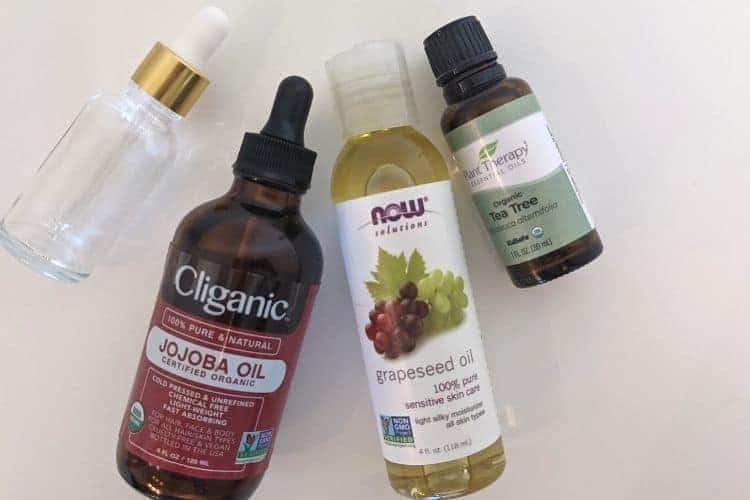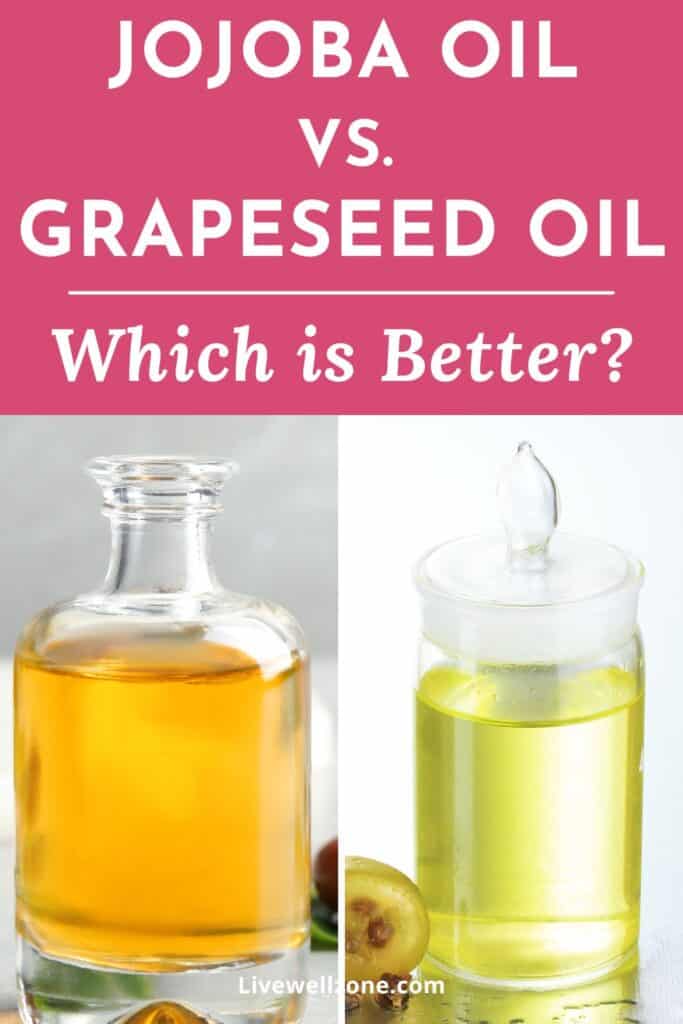
Grapeseed and jojoba oil are both versatile carrier oils that work for just about every skin type. However, like all carrier oils, there are some subtle and important differences once you take a closer look at them. So, we’re going to look at grapeseed oil vs jojoba oil for skin, focusing mainly on:
- their chemical composition and general uses.
- how to mix them.
- some of the best brands to use.
GRAPESEED OIL VS JOJOBA OIL FOR FACE: MAIN BENEFITS FOR OILY SKIN, ACNE AND MORE
| GRAPESEED OIL | JOJOBA OIL | |
|---|---|---|
| Regulates sebum production | ✓ | |
| Contains vitamin E | ✓ | ✓ |
| Contains antioxidants | ✓ | ✓ |
| Antibacterial | ✓ | ✓ |
| Emollient properties | ✓ | ✓ |
| Occlusive and supports skin barrier | ✓ | ✓ |
| Very lightweight | ✓ | |
| Fast to absorb | ✓ | ✓ |
| Suitable for all skin types | ✓ | ✓ |
BENEFITS AND CHARACTERISTICS OF GRAPESEED OIL (Sources: 1, 2)
- Has a very lightweight consistency and absorbs rapidly. So, it doesn’t leave the skin feeling greasy nor does it clog pores. This makes it particularly beneficial for oily and acne-prone skin (though all other skin types can also use it).
- rich in essential fatty acids, including linoleic acid, which plays an important role in maintaining proper skin barrier function. The concentration of linoleic acid in grapeseed oil is generally between 66 – 75.3%, depending on the grape and the particular batch/harvest.
- contains tocotrienols and tocopherols, which are both natural forms of vitamin E. Vitamin E is known for its antioxidant and emollients (skin-softening) properties.
- acts as an occlusive agent, meaning it forms a protective film on the skin that helps to lock in moisture.
- rich in antioxidants such as resveratrol, carotenoids and flavonoids.
- contains phytochemicals that are known to prevent skin cancer and damage from sun exposure.
- rich in phenols which are compounds that have both antioxidant and antibacterial activity.
BENEFITS AND CHARACTERISTICS OF JOJOBA OIL (Sources: 3, 4)
- Unlike grapeseed oil, jojoba oil is a liquid wax. Chemically, it is made of wax esters.
- Has a slightly heavier consistency compared to grapeseed oil, but still absorbs quickly without leaving a greasy residue. Suitable for all skin types.
- Can help to regulate sebum production. This is because 25% of sebum is made of wax esters (which are also found in jojoba). Some experts believe that topical application of jojoba oil can trick the skin into producing less sebum.
- Contains a high amount of eicosenoic acid which is an omega-9 fatty acid that is naturally present in sebum. This is yet another reason why jojoba balances sebum and can be helpful for oily and acne-prone skin.
- Has occlusive properties, meaning that it creates a protective film on the skin that prevents water from evaporating.
- Research shows that jojoba oil helps inflammatory conditions like acne and psoriasis.
- Contains vitamins A, D and E which encourage cell turnover, fight inflammation and fight off free radicals respectively.
- Contains antioxidants like phenols, which are antibacterial (likely another reason why jojoba improves acne).
HOW TO MIX GRAPESEED OIL WITH JOJOBA OIL

When mixing grapeseed and jojoba oil, you need a clean glass bottle in which to store your blend. The steps below show you how to make a blend for a 1 ounce bottle like this one.
As for which brands to use, there are plenty to choose from:
- For jojoba, I like this one from Cliganic
- As for grapeseed oil, I’ve been a longtime fan of this one from Now.
1. Determine your skin type
- Oily skin: since jojoba helps to balance sebum levels and grapeseed is non-greasy, you can try a 50-50 blend of jojoba and grapeseed oil. If you prefer a very light consistency, then try 70% grapeseed and 30% jojoba.
- Oily and Acne-prone skin: jojoba’s sebum-regulating properties can help to minimize the clogging of pores. So, consider using a higher ratio of jojoba to grapeseed. For example, 60 – 70% jojoba and 30 – 40% grapeseed.
- Dry or mature skin: jojoba’s slightly thicker texture and proven skin barrier benefits will be particularly helpful. Consider trying a higher ratio of jojoba to grapeseed. For example, 60 – 70% jojoba (or even more) depending on just how dry your skin is.
- Combination skin: try a 50-50 blend of grapeseed and jojoba.
- Sensitive skin: some sensitive skin can also be dry, oily or acne-prone. So, refer to the tips for each of those skin types to figure out what makes sense for you.
2. Add the oils to a glass bottle
Use the chart below to determine how much of each oil to add into your 1 ounce bottle.
| 50-50 blend | 1 Tbsp each of oil |
| 60-40 blend | 3.5 Tbsp of one oil and 2.5 of the other |
| 70-30 blend | 4.25 tsp of one oil and 1.5 tsp of the other |
| 80-20 blend | 4.75 tsp of one oil and 1.25 tsp of the other |
3. Add essential oils (optional)
Adding essential oils to your blend can be helpful, particularly if you’re struggling with something like acne.
In this case, the most popular oil to use is tea tree oil at a 5% dilution (research has shown this dilution to be effective for mild to moderate acne). So, for a 1 ounce bottle you will need 45 drops of tea tree oil.
In addition, there are oils that can be beneficial for aging skin, such as:
- helichrysum.
- frankincense.
- rose.
- myrrh.
- lavender.
- geranium.
For the above oils, a maximum dilution of 1.5% dilution is generally recommended (source). For a 1 ounce bottle, this is equivalent to 13 drops.
FAQs ABOUT JOJOBA AND GRAPESEED OIL
Can you use grapeseed oil instead of jojoba?
For acne-prone skin, grapeseed oil can be used as a substitute for jojoba oil. Just keep in mind that jojoba initially feels a little heavier when applied to the skin (although it absorbs into the skin very well). In addition, if you’re making your own face oil, it is possible to replace jojoba with grapeseed oil. However, remember that:
- grapeseed oil has a lighter color than jojoba. So, the final color of your product might be affected.
- since jojoba is a little thicker than grapeseed, it can affect the overall weight of your face oil blend (depending on the other ingredients in the mix).
Is grapeseed oil good for wrinkles?
Due to its high antioxidant content – including vitamin E, which is an emollient – grapeseed can be used as a natural remedy for wrinkles. Combining it with other anti-aging oils – like rosehip, argan and jojoba – can help to boost the wrinkle-smoothing effect.
CONCLUSION: WHICH IS BETTER JOJOBA OR GRAPESEED OIL?
Although jojoba and grapeseed oil are great for all skin types, they can be particularly helpful for oily skin. In addition, for anyone with oily/acne-prone skin, jojoba might be a better choice thanks to its ability to regulate sebum production.
These oils can be used on their own or in a blend, depending on your personal preference. As always, it’s a good idea to experiment and see which one your skin prefers.

You Might Also Enjoy:
Rosehip Oil vs Jojoba Oil for Face (And Body): Which is Better and How To Use
What To Mix With Jojoba Oil For Face – The Ultimate Guide
Vitamin E Oil vs Jojoba Oil For Skin: Everything You Need to Know
Best Oils for Acne Prone Skin: Carrier, Essential and Cleansing Oils You Shouldn’t Ignore
Grapeseed Oil vs Rosehip Oil for Skin: Benefits, Which Is Better and Uses
Non-Greasy Carrier Oils For Skin: 10 Oils To Fall In Love With
What To Mix With Shea Butter for Skin and Hair: Tips and Recipes

